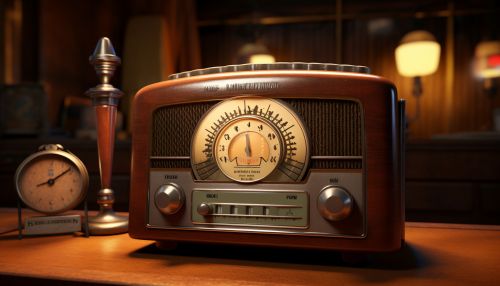Radio
Introduction
Radio is a technology that allows for the transmission of signals by modulation of electromagnetic waves. These waves, which are not required to travel through a specific medium, can pass through the atmosphere, vacuum, and physical objects, "wireless" transmission. The term "radio" is derived from the Latin word "radius", meaning "beam of light" or "spoke of a wheel". Radio, in a broader context, can be understood as the transmission and reception of electromagnetic waves of radio frequency, especially those carrying sound messages.
History
The concept of radio has its roots in the experiments of James Clerk Maxwell and Michael Faraday, who worked on the theories of electromagnetic fields and electromagnetic induction, respectively. The practical application of these theories was realized by H. Hertz, who demonstrated the existence of radio waves in the late 19th century. Following Hertz's experiments, several inventors and scientists, including G. Marconi, developed methods to harness these waves for communication.


Radio Wave Propagation
Radio signals are propagated in various ways depending on the frequency of the signal. The propagation of radio waves is influenced by the earth's atmosphere, the ionosphere, and the troposphere. Direct waves travel directly from the antenna to the receiving device. Ground waves refer to radio waves that travel along the Earth's surface, while skywaves are reflected back to Earth from the ionosphere. Understanding the propagation of radio waves is crucial for effective radio communication.
Radio Communication Systems
Radio communication systems use a transmitter to create a radio wave that is impressed with a signal for transmission. This signal can be audio, video, or digital data. The transmitter sends the signal to a receiver, which extracts the desired information. The receiver uses an antenna to capture the radio signal, and the antenna's properties are critical for effective reception.
Radio Broadcasting
Radio broadcasting is a unidirectional wireless transmission, intended for direct reception by the general public. This system is commonly used for public information and entertainment, via the medium of FM and AM radio stations. Broadcasting includes both private and public radio stations. In addition to audio signals, digital radio allows the transmission of multimedia content.
Amateur Radio
Amateur radio, also known as ham radio, is a popular hobby and service that brings people, electronics, and communication together. People use ham radio to talk across town, around the world, or even into space. It's fun, social, educational, and can be a lifeline during times of need.
Radio Spectrum
The radio spectrum is the part of the electromagnetic spectrum with frequencies from 30 Hertz to 300 Gigahertz. It is divided into several bands based on the wavelength. These bands are used for different types of radio communication, including television broadcasting, mobile networks, satellite communication, and more.
Radio Technology in Other Fields
Radio technology is not limited to communication and broadcasting. It is also used in other fields such as navigation, radar, space communication, and remote control devices. The principles of radio are also applied in wireless technology such as Bluetooth and Wi-Fi.
